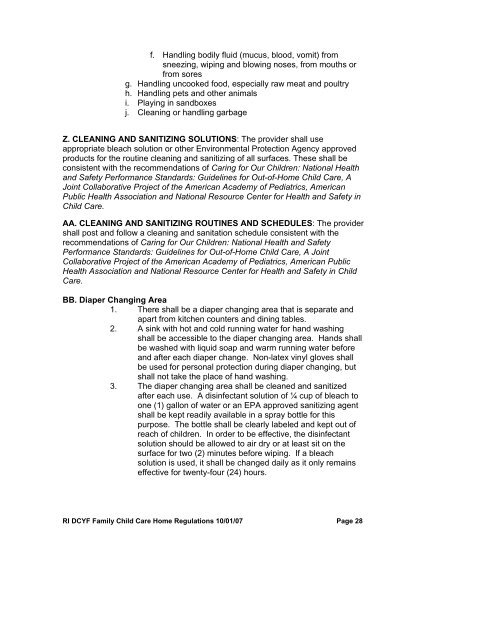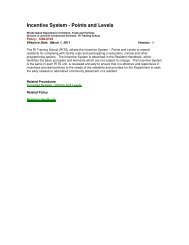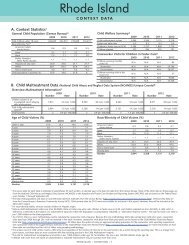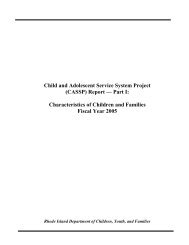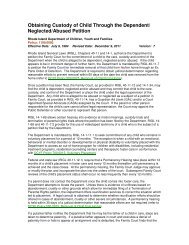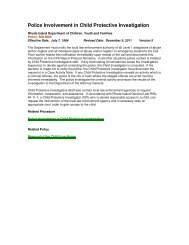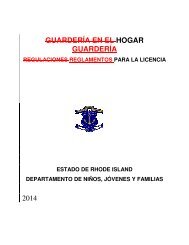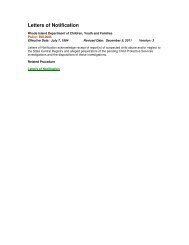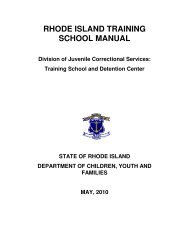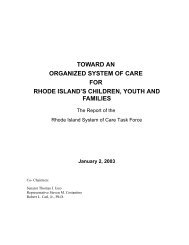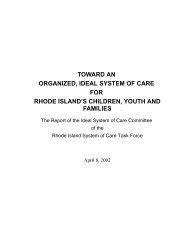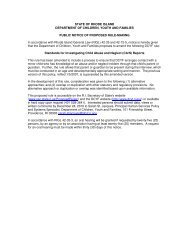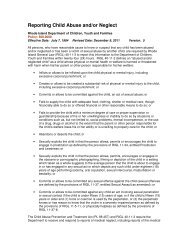Family Child Care Home Regulations for Licensure - RI Department ...
Family Child Care Home Regulations for Licensure - RI Department ...
Family Child Care Home Regulations for Licensure - RI Department ...
You also want an ePaper? Increase the reach of your titles
YUMPU automatically turns print PDFs into web optimized ePapers that Google loves.
f. Handling bodily fluid (mucus, blood, vomit) from<br />
sneezing, wiping and blowing noses, from mouths or<br />
from sores<br />
g. Handling uncooked food, especially raw meat and poultry<br />
h. Handling pets and other animals<br />
i. Playing in sandboxes<br />
j. Cleaning or handling garbage<br />
Z. CLEANING AND SANITIZING SOLUTIONS: The provider shall use<br />
appropriate bleach solution or other Environmental Protection Agency approved<br />
products <strong>for</strong> the routine cleaning and sanitizing of all surfaces. These shall be<br />
consistent with the recommendations of Caring <strong>for</strong> Our <strong>Child</strong>ren: National Health<br />
and Safety Per<strong>for</strong>mance Standards: Guidelines <strong>for</strong> Out-of-<strong>Home</strong> <strong>Child</strong> <strong>Care</strong>, A<br />
Joint Collaborative Project of the American Academy of Pediatrics, American<br />
Public Health Association and National Resource Center <strong>for</strong> Health and Safety in<br />
<strong>Child</strong> <strong>Care</strong>.<br />
AA. CLEANING AND SANITIZING ROUTINES AND SCHEDULES: The provider<br />
shall post and follow a cleaning and sanitation schedule consistent with the<br />
recommendations of Caring <strong>for</strong> Our <strong>Child</strong>ren: National Health and Safety<br />
Per<strong>for</strong>mance Standards: Guidelines <strong>for</strong> Out-of-<strong>Home</strong> <strong>Child</strong> <strong>Care</strong>, A Joint<br />
Collaborative Project of the American Academy of Pediatrics, American Public<br />
Health Association and National Resource Center <strong>for</strong> Health and Safety in <strong>Child</strong><br />
<strong>Care</strong>.<br />
BB. Diaper Changing Area<br />
1. There shall be a diaper changing area that is separate and<br />
apart from kitchen counters and dining tables.<br />
2. A sink with hot and cold running water <strong>for</strong> hand washing<br />
shall be accessible to the diaper changing area. Hands shall<br />
be washed with liquid soap and warm running water be<strong>for</strong>e<br />
and after each diaper change. Non-latex vinyl gloves shall<br />
be used <strong>for</strong> personal protection during diaper changing, but<br />
shall not take the place of hand washing.<br />
3. The diaper changing area shall be cleaned and sanitized<br />
after each use. A disinfectant solution of ¼ cup of bleach to<br />
one (1) gallon of water or an EPA approved sanitizing agent<br />
shall be kept readily available in a spray bottle <strong>for</strong> this<br />
purpose. The bottle shall be clearly labeled and kept out of<br />
reach of children. In order to be effective, the disinfectant<br />
solution should be allowed to air dry or at least sit on the<br />
surface <strong>for</strong> two (2) minutes be<strong>for</strong>e wiping. If a bleach<br />
solution is used, it shall be changed daily as it only remains<br />
effective <strong>for</strong> twenty-four (24) hours.<br />
<strong>RI</strong> DCYF <strong>Family</strong> <strong>Child</strong> <strong>Care</strong> <strong>Home</strong> <strong>Regulations</strong> 10/01/07 Page 28


